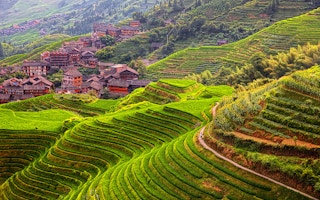Speeding up efforts to reverse or prevent land degradation in Small Island Developing States (SIDS) is vital in the next few years if the Sustainable Development Goals are to be achieved.
That was the message at an event hosted by FAO this week during the 13th session of the Conference of the Parties (COP13) to the UN Convention to Combat Desertification (UNCCD).
An assessment of degraded lands in Small Island Developing States is being developed based on the collection and analysis of land-use information and management practices of the land users.
The data is obtained using the Land Degradation Assessment (LADA) methodology which has already been successfully applied in over 30 countries. The assessment results will be used in formulating policies and making decisions to address climate change and boost the resilience of people and their landscapes.
“For the first time, all countries can equally contribute to global assessments of degraded land and define their own restoration opportunities,” said René Castro, Assistant Director-General of FAO’s Climate, Biodiversity, Land and Water Department, at COP13 which is being held in Ordos, China.
In addition, under a partnership with Google funded by Germany and the European Union, FAO aims by mid-2018 to show global trends in land coverage, land productivity and carbon installations above and below ground.
FAO is so far working with 30 countries to produce national data, including training local teams to assess land use changes and degradation by using remote sensing and participative approaches in working with local communities.
Assessments like these can help countries build their national land degradation neutrality targets to promote sustainable land management and restoration practices. Land degradation neutrality is one of the targets under Sustainable Development Goal 15: Life on Land, and it means to maintain or improve the amount of healthy and productive land resources over time, in line with national sustainable development priorities.
Reversing land degradation can boost soil productivity, increase water retention and contribute to sustainable livelihoods and people’s resilience. In Central America, for example, by restoring land through adding trees and grass cover, farmers were able to sustainably increase from one cow per hectare per year to four.
Land degradation neutrality can also support a range of other SDGs such as achieving Zero Hunger (SDG 2), access to water (SDG 6) and effective climate action (SDG 13).
Action in the islands
Cabo Verde was the first island state to conduct an assessment of the status of land degradation at the national level using the high-resolution satellite imagery. A team of technical experts coordinated by the Ministry of Agriculture and Environment was supported by FAO to carry out the analysis.
“Early results of the initiative show that degraded lands in Cabo Verde have been restored, although much more is needed,” said Gilberto Correia Carvalho Silva, the Minister of Agriculture and Environment during the high-level event at COP13 hosted by FAO.
The assessment tool has already been used successfully in the Great Green Wall initiative to build a wall of trees across the width of Africa, and is now a vital instrument in providing critical information to understand the true dimension of restoration needs in Small Island Development States.
Better partnerships and more tools for land degradation neutrality
To achieve land degradation neutrality quicker, FAO and the Global Mechanism of the UN Convention to Combat Desertification strengthened their collaboration through an agreement signed at the high-level event.
The collaboration aims to support Small Island Developing States to set national targets to achieve land degradation neutrality. As well as being the foremost global custodian of agriculture-related data, FAO provides SIDS countries with expertise in policy development on sustainable land management and addressing land degradation, including governance and land rights.
During COP13, FAO also launched a Land Resource Planning Toolbox, an online, searchable database that contains valuable information on available tools, their objectives, target groups, case studies and much more to support countries and practitioners promote sustainable land management.










